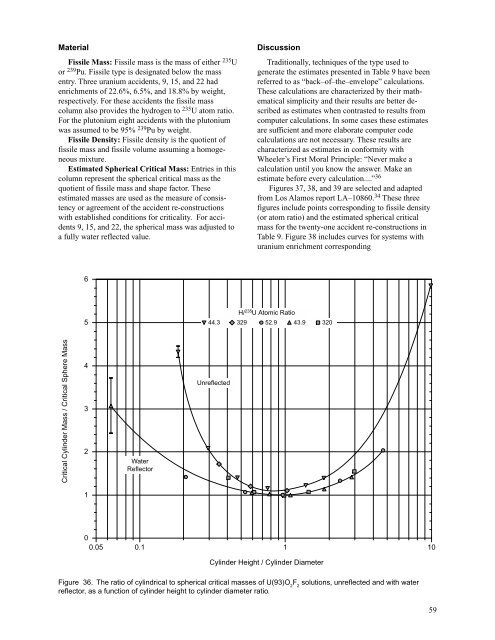A Review of Criticality Accidents A Review of Criticality Accidents
A Review of Criticality Accidents A Review of Criticality Accidents
A Review of Criticality Accidents A Review of Criticality Accidents
Create successful ePaper yourself
Turn your PDF publications into a flip-book with our unique Google optimized e-Paper software.
Material<br />
Fissile Mass: Fissile mass is the mass <strong>of</strong> either 235U or 239Pu. Fissile type is designated below the mass<br />
entry. Three uranium accidents, 9, 15, and 22 had<br />
enrichments <strong>of</strong> 22.6%, 6.5%, and 18.8% by weight,<br />
respectively. For these accidents the fissile mass<br />
column also provides the hydrogen to 235U atom ratio.<br />
For the plutonium eight accidents with the plutonium<br />
was assumed to be 95% 239Pu by weight.<br />
Fissile Density: Fissile density is the quotient <strong>of</strong><br />
fissile mass and fissile volume assuming a homogeneous<br />
mixture.<br />
Estimated Spherical Critical Mass: Entries in this<br />
column represent the spherical critical mass as the<br />
quotient <strong>of</strong> fissile mass and shape factor. These<br />
estimated masses are used as the measure <strong>of</strong> consistency<br />
or agreement <strong>of</strong> the accident re-constructions<br />
with established conditions for criticality. For accidents<br />
9, 15, and 22, the spherical mass was adjusted to<br />
a fully water reflected value.<br />
Critical Cylinder Mass / Critical Sphere Mass<br />
6<br />
5<br />
4<br />
3<br />
2<br />
1<br />
Water<br />
Reflector<br />
Discussion<br />
Traditionally, techniques <strong>of</strong> the type used to<br />
generate the estimates presented in Table 9 have been<br />
referred to as “back–<strong>of</strong>–the–envelope” calculations.<br />
These calculations are characterized by their mathematical<br />
simplicity and their results are better described<br />
as estimates when contrasted to results from<br />
computer calculations. In some cases these estimates<br />
are sufficient and more elaborate computer code<br />
calculations are not necessary. These results are<br />
characterized as estimates in conformity with<br />
Wheeler’s First Moral Principle: “Never make a<br />
calculation until you know the answer. Make an<br />
estimate before every calculation....” 36<br />
Figures 37, 38, and 39 are selected and adapted<br />
from Los Alamos report LA–10860. 34 These three<br />
figures include points corresponding to fissile density<br />
(or atom ratio) and the estimated spherical critical<br />
mass for the twenty-one accident re-constructions in<br />
Table 9. Figure 38 includes curves for systems with<br />
uranium enrichment corresponding<br />
H/ 235U Atomic Ratio<br />
44.3 329 52.9 43.9 320<br />
Unreflected<br />
0<br />
0.05 0.1 1 10<br />
Cylinder Height / Cylinder Diameter<br />
Figure 36. The ratio <strong>of</strong> cylindrical to spherical critical masses <strong>of</strong> U(93)O 2 F 2 solutions, unreflected and with water<br />
reflector, as a function <strong>of</strong> cylinder height to cylinder diameter ratio.<br />
59

















